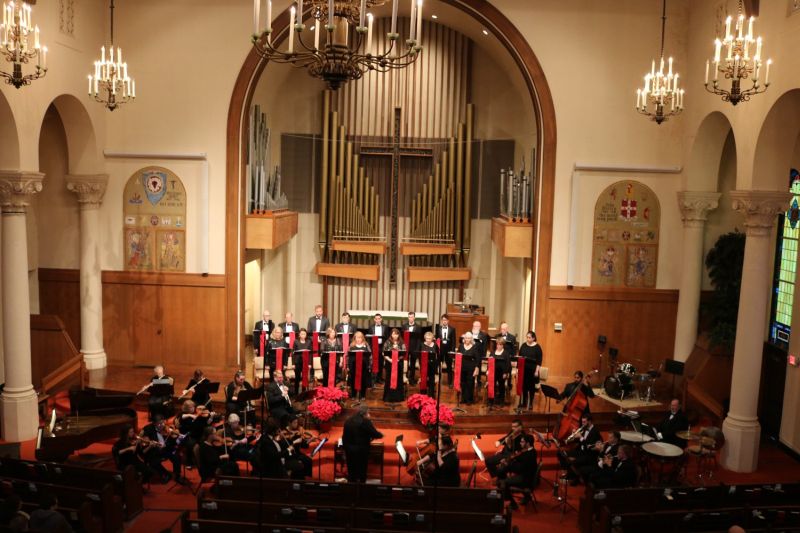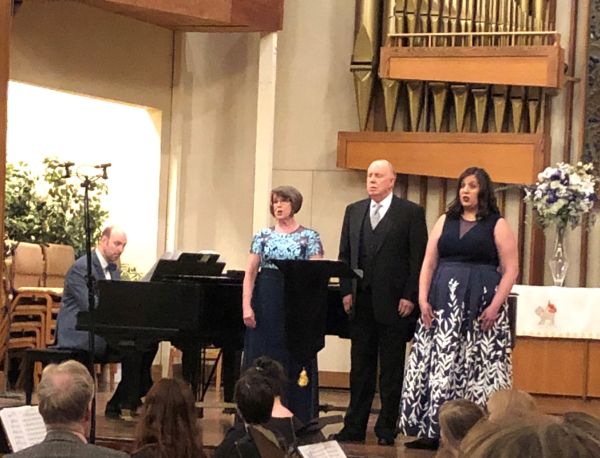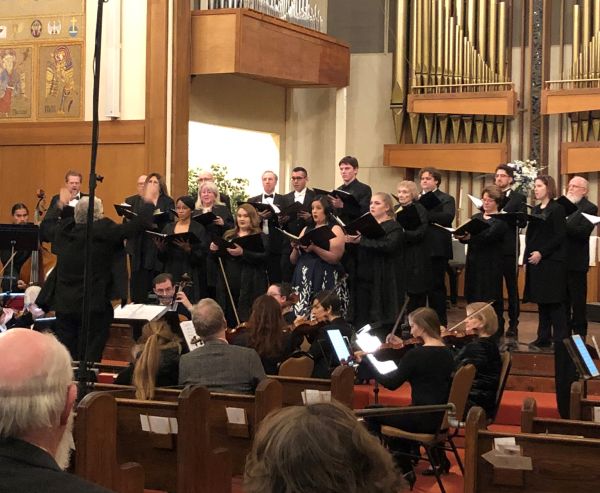Choral Review
Camerata California
An Afternoon with the Master - January 12, 2020
An all-Mozart concert on a cold, late Sunday afternoon in January ― what could be better? Almost two weeks into the new year, and with a three-week rest from non-stop Christmas music, a concert of Mozart felt like a cleansing of the artistic palette before the initiation of the spring choral season.
The sun was still streaming through the stained-glass windows on the southwestern wall of Sacramento’s First United Methodist Church when the singers of Camerata California began entering the sanctuary. The 20-piece orchestra were seated and tuned, but the entrance of the singers signaled that the concert was about to begin, and the audience welcomed them with scattered applause that grew to a peak when conductor Pete Nowlen appeared at the entry door. Nowlen took his place on the conductor’s podium and, without preliminaries, began directing Mozart’s Mass in C Major (The Coronation Mass). It took just a few seconds of the opening measures of the Kyrie for me to conclude that we would be getting an authentic performance of this well-loved work of the master ― brisk tempo, crisp articulation by orchestra and chorus ― and intelligent, responsive singing from a select group, most of whom had performed this piece before ― perhaps many times.
(Click here to open the concert program in a new window.)
Camerata California bills itself as “an exceptional chamber choir.” I have attended their concerts for 8 years, and I can attest to the truth of that claim. Each of the 18 singers has an impressive bio, as you can tell from the attached program. Furthermore, the strength of the choir is demonstrated by the fact that they could give an impressive performance of this music with so few singers: typically only much larger choral organizations would attempt it. Apart from the experience of these singers, it is notable that nearly all the women have significant solo credentials, and more than half are currently studying ― or teaching ― voice.
In this performance of the Coronation Mass, each singer stood behind their own music stand, allowing a singing posture uninhibited by having to hold a music score. The soloists ― soprano Ava DeLara, mezzo-soprano Savannah Swan, tenor Matt Hidalgo, and bass Nathan Halbur ― stood among their fellow chorus members, singing the chorus parts with them. In the Kyrie, I was initially impressed with the strong, pure tone of DeLara (which I have heard from her so often before). But each of the other soloists came through with technically excellent, balanced, listenable performances.
 |
| Camerata California in an earlier concert at First United Methodist Church, Sacramento |
There is something about the choral works of Mozart ― at least those with which I am familiar. It is a special aesthetic appeal that underlies what a pleasure it is to sing ― or hear. That’s my best explanation for why I completely abandoned any analysis of what I was hearing ― surrendering to the pleasure ― until I was taken aback by the sombre passion of “passus est” in the Credo, so quickly followed by the chorus’s convincing exultation in “et resurrexit.”
The Sanctus movement brought the first consistently slower tempos, allowing me to appreciate the expressive playing of the strings. Their delicate introduction to the Benedictus movement was simply transporting under the careful guidance of conductor Pete Nowlen. And that movement showcased the thoughtful singing of the quartet: good balance, deference to the part carrying the major melody, with no hint of oversinging. Then the extended soprano solo at the beginning of the Agnus Dei gave DeLara another opportunity to demonstrate what a fine singer she is, matching beautiful, accurate intonation to a beautiful melody. Then, after another shining moment for the quartet, the full ensemble took over to bring the piece to a conclusion.
I thought about the many elderly people in the audience, some of whom I had observed struggling to enter the church with walkers and canes. I imagined that they had spent a lifetime appreciating Mozart. What else could justify the struggle to attend? For them, this was surely the performance they could have hoped for, and that was attested to by the enthusiastic applause which followed the mass, with many of those elderly people on their feet.
During the 15-minute intermission, the orchestra thinned, and the chorus members took seats in the audience. Presently, the next section of the afternoon’s program began with the entrance of three solo performers: Robin Fisher, Burr C. Phillips, and Valerie Loera. Fisher is Professor of Voice in the Sacramento State School of Music. Phillips is Professor of Voice in the University of the Pacific’s Conservatory of Music. And Loera is currently a student of Fisher’s pursuing a Masters of Music in Vocal Performance at Sac State. All 3 performers have an impressive range of experience, and you should check their bios in the attached program. Entering with them was Sacramento’s premier organist, Ryan Enright, who would be accompanying them on the piano.
 Fisher introduced the suite of 4 opera excerpts, giving a bit of
background on Mozart’s operas and a translation of the text of the first
duet, which was to be performed (of course) in German. Note it’s listed
third in the attached program: Bei Mämmern, welche Liebe Fühlen from
Die Zauberflöte (The Magic Flute).
Fisher introduced the suite of 4 opera excerpts, giving a bit of
background on Mozart’s operas and a translation of the text of the first
duet, which was to be performed (of course) in German. Note it’s listed
third in the attached program: Bei Mämmern, welche Liebe Fühlen from
Die Zauberflöte (The Magic Flute).
When Fisher began to sing her part of the duet, I was instantly impressed by the quality of her voice ― the expressive and rich sound, her effortless delivery, and her limber navigation of the musical ornamentation. I should have known what to expect because I have seen her on the program of so many musical events in recent years ― though (remarkably) this was my first opportunity to hear her perform.
I had not been aware of Phillips’ public performances before this,
but I wish I had been. His restrained, clear tone in this duet and his
confident manner were arresting to me. His singing was masterful and
eminently listenable, and I can’t think of another baritone I’ve heard
in recent years who I would rather hear performing.

Next was Fisher’s solo of “Welcher Wechsel… Traurigkeit ward mir zum Lose” from Die Entführung aus dem Serail (The Abduction from the Seraglio or Il Seraglio). Again, she preceded her singing with a summary of the dramatic situation and a translation of the text. I noted immediately that she was performing the aria from memory. (The score was on the music stand for the previous selection.) As she sang, it felt more like an excerpt from the opera, rather than a concert performance. She was clearly telling a story, conveying the passion of the scene, occasionally with the help of soaring high notes. Most of us in the audience couldn’t understand the words, but it was pleasant, engaging listening nonetheless.
Phillips was next in his performance of “Non più andrai” from Le Nozze di Figaro (The Marriage of Figaro). Like Fisher, he began with a summary of the setting of the aria, which he then performed from memory. He seemed more expressive in this solo than he was during the duet, and I got the impression that he must have performed this part in the full opera, though it was a little strange entertaining that thought and watching him sing in a 3-piece suit. Finally, having been singing about Cherubino’s going off to military service, Phillips, as Figaro, ended with a sharp salute. Nice touch.
The last selection of Mozart’s opera music was the trio, “Soave sia il vento” from Cosi Fan Tutte. Once again, Phillips introduced the music, giving the setting of the piece and a translation of the Italian. For this piece, Valerie Loera joined Fisher and Phillips, and I found her to be an effective addition to the more experienced singers. Loera, though currently a student of Fisher, has compiled a significant singing resume of her own. In my notes, I observed that Fisher and Phillips seemed relaxed, poised, and connected to the audience. Loera seemed only a little less so. Yet the singing of the three of them was well matched, and their performance was full of feeling.
 |
 |
| Ryan Enright, Robin Fisher, Burr Phillips & Valerie Loera | Camerata California performing Regina Coeli |
At the conclusion of these 4 “opera highlights,” Phillips turned the audience’s attention to Ryan Enright, whose competent, understated, precise playing gave excellent support to the singers. Phillips noted how lucky they were to have an accompanist of Enright’s stature.
After another brief intermission, the chorus returned to the stage to perform the final two selections. For what was to follow, they would forego their music stands and hold their scores, standing in a somewhat disorganized formation surrounding Robin Fisher. The music was “Laudate Dominum” from Mozart’s Vesperae Solennes de Confessore. Unfamiliar though the title may be, the music itself would be familiar to just about everyone ― I think I recall even hearing it in movie soundtracks. It’s a stunningly beautiful piece, and it felt like it was lovingly performed. The soprano solo is at the heart of the piece, and listening to Robin Fisher (singing from memory), I began to understand the meaning of “lyric” in “lyric soprano.”
At this point in the concert, Fisher departed, and Pete Nowlen spoke for the first time. He thanked the audience for coming and thanked all the performers for their contribution to this afternoon’s “survey of Mozart’s vocal music.” Reflecting on the start of a new decade, Nowlen said that one of his greatest joys of the past decade was working with Camerata California, and he made a special point of recognizing the group's General Director, Mary Wesley (who acknowledged the audience’s applause from her position among the altos in the chorus). Then Nowlen turned to direct the final selection, which he described as one of his favorites: Regina Coeli in C Major, K. 276 (Mozart wrote two settings). It is jubilant music, and Nowlen’s high-energy directing was reflected in the inspired singing of the chorus (and soloists). You could just feel the joyfulness, along with the contrasting delicate moments characterized by exquisitely restrained singing.
With the concert concluded and the audience applauding on their feet, Nowlen made the gracious gesture of not simply acknowledging the soloists from his conductor’s platform but going up among the chorus to shake their hands. Then as audience and performers dispersed into the cold evening air, the thought came to me that surely they, as I, felt warmed by our “Afternoon with the Master.”
Dick Frantzreb is editor of the Capital Region Performance Gallery. He also edits the Sacramento Choral Calendar and the Placer Performance Calendar, and he was a co-founder and past President of the Sacramento Valley Choral Coalition. He has been loving live performances in the greater Sacramento area and writing about them since 2012.